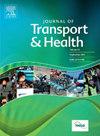Active transportation and well-being among different age groups: A network analysis approach in Taiwan
IF 3.3
3区 工程技术
Q2 PUBLIC, ENVIRONMENTAL & OCCUPATIONAL HEALTH
引用次数: 0
Abstract
Background
Active transportation has well-documented benefits for both personal health and environmental sustainability, yet its adoption rate remains relatively low in many developed contexts. A life course perspective helps understand how transportation behaviors and their implications for well-being evolve alongside age-related changes. This study examines how the relationship between active transportation and well-being is embedded within broader sociodemographic, health, and environmental perception contexts across different age groups.
Method
Using nationally representative web survey data from Taiwan in 2019 (N = 1437), we applied network analysis to map the interconnections among multidimensional factors. Analyses were stratified across four life stages: Early adulthood (18–29 years), Prime adulthood (30–49 years), Mature adulthood (50–64 years), and Older adulthood (65+ years).
Results
The sample revealed low rates of active transportation usage in Taiwan, with walking and cycling accounting for only 5.3 % and public transportation for 20.2 %. Network analysis indicated that active transportation was not directly associated with well-being but exerted indirect effects through the perceived availability of pedestrian space. Age-specific patterns showed that sociodemographic factors, including education and income, influenced active transportation across all age groups, becoming stronger from prime adulthood and peaking in mature adulthood; being female had a direct association only in mature adulthood. In older adulthood, eye discomfort emerged as a key factor shaping transportation choices.
Discussion
These results support life course theory, highlighting that the well-being benefits of active transportation are shaped by age-specific sociodemographic constraints and environmental factors. Transportation planning should consider age-specific needs and prioritize pedestrian infrastructure to better support population mobility and well-being.
台湾不同年龄族群的主动交通与幸福感:网路分析方法
主动交通对个人健康和环境可持续性都有充分的好处,但在许多发达国家,它的采用率仍然相对较低。生命历程视角有助于理解交通行为及其对健康的影响是如何随着年龄的变化而演变的。本研究探讨了主动交通与幸福感之间的关系如何嵌入到不同年龄组的更广泛的社会人口、健康和环境感知背景中。方法利用2019年台湾地区具有全国代表性的网络调查数据(N = 1437),运用网络分析方法绘制多维因素之间的相互关系。分析分为四个生命阶段:早期成年(18-29岁)、壮年期(30-49岁)、成年期(50-64岁)和老年期(65岁以上)。结果调查结果显示,台湾居民使用主动交通工具的比例较低,步行和骑自行车的比例仅为5.3%,公共交通的比例为20.2%。网络分析表明,主动交通与幸福感没有直接关系,但通过感知步行空间的可用性产生间接影响。按年龄划分的模式表明,包括教育和收入在内的社会人口因素对所有年龄组的主动交通都有影响,从壮年开始变得更强,在成年期达到顶峰;女性身份只有在成年期才有直接关联。在老年人中,眼睛不适成为影响交通选择的关键因素。这些结果支持了生命历程理论,强调了主动交通的福利是由特定年龄的社会人口限制和环境因素决定的。交通规划应考虑特定年龄的需求,并优先考虑行人基础设施,以更好地支持人口流动和福祉。
本文章由计算机程序翻译,如有差异,请以英文原文为准。
求助全文
约1分钟内获得全文
求助全文

 求助内容:
求助内容: 应助结果提醒方式:
应助结果提醒方式:


